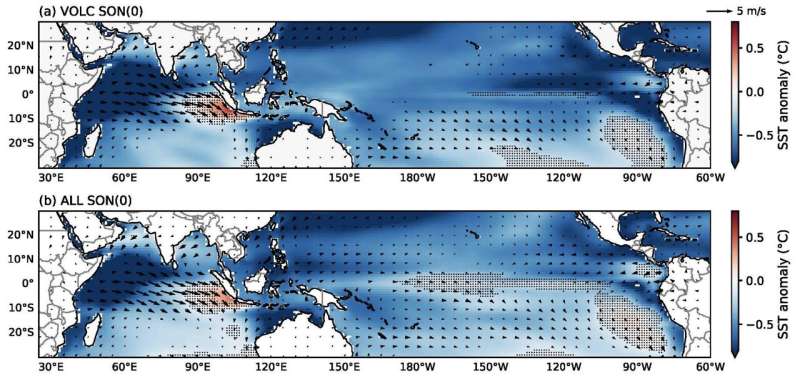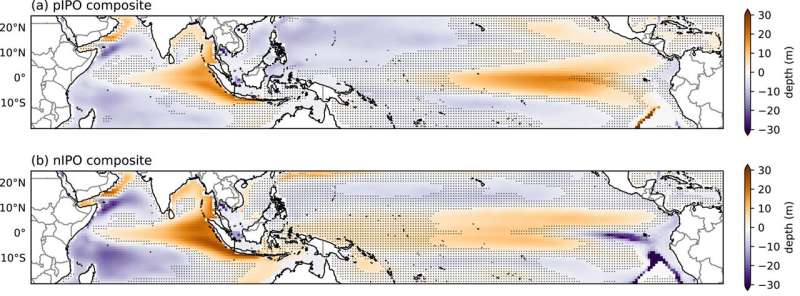October 27, 2023 feature
This article has been reviewed according to Science X's editorial process and policies. Editors have highlighted the following attributes while ensuring the content's credibility:
fact-checked
peer-reviewed publication
trusted source
proofread
Volcanic eruptions found to dampen Indian Ocean El Niño events for up to 8 years

Volcanic eruptions occurring in tropical regions (23°N/S of the equator) have been linked to abrupt disruption of global-scale climate cycles in the Indian Ocean over the last 1 million years in new research published in Geophysical Research Letters. El Niño Southern Oscillation (ENSO) and Indian Ocean Dipole (IOD) are ocean-atmosphere climate interactions that were found to be disrupted for almost a decade before returning to pre-eruption baseline levels, and the effect increases with greater eruption intensity.
The IOD occurs due to an east-west contrast in sea surface temperatures, with cooler than normal temperatures in the eastern Indian Ocean and warmer to the west. During the positive phase, this results in considerable changes to temperature, precipitation and wind patterns in neighboring regions, with floods typically occurring in East Africa and drought in east Asia and Australia. These conditions reverse during a negative IOD phase.
Benjamin Tiger, from Massachusetts Institute of Technology and Woods Hole Oceanographic Institution (WHOI) Joint Program in Oceanography/Applied Ocean Sciences and Engineering, USA, and Dr Caroline Ummenhofer, also from WHOI, modeled simulations using Community Earth System Model Last Millennium Ensemble (CESM-LME) and input data from some of the largest historical eruptions, including Samalas (1258), Kuwae (1452), Tambora (1815), Huaynaputina (1600) and Pinatubo (1991).
They determined that strong volcanic eruptions in the tropics induce a negative IOD within the eruption year, following by a positive phase the next year and that the effect is significant enough to outweigh the general cooling trend observed in the tropics post-eruption. These positive and negative IOD anomalies last for 7–8 years after the eruption, before the signal returns to pre-eruption conditions.
This pattern is further impacted by the phase of another co-occurring climate cycle, the Interdecadal Pacific Oscillation (IPO), which lasts for 20–30 years and occurs over a larger area spanning both hemispheres. During positive phases the tropical Pacific Ocean is warmer and northern regions cooler, with the reverse in negative phases.
The researchers found that a negative IPO phase resulted in a stronger negative IOD and the same for a positive IPO/IOD, making tropical Pacific sea surface temperature during IPO a key influence on the strength of initial IOD response.

Meanwhile, ENSO oscillations (where Pacific Ocean sea surface temperature changes up to 3°C and results in climate shifts) correspond to El Niño warming after large tropical eruptions, particularly in boreal winter months (December–February) of the first year after the volcanic event, with La Niña conditions predominating thereafter.
This may be explained by an enhanced temperature gradient between land and sea of Africa and the Indian Ocean, influencing westerly trade winds, as well as a region of upwelling cooler water in the eastern Pacific. Tiger and Dr Ummenhofer also found that the ENSO response lagged behind that of positive IOD by 2 months. Meanwhile, the simulations identified negative IOD coinciding with strong La Niña conditions in years 3–5 post-eruption.
Another factor affecting sea surface temperature, and therefore climate responses, is the depth of the thermocline (an abrupt temperature gradient) within the Indian and Pacific oceans. Eruptions occurring in positive IPO conditions have a shallower thermocline in the Indo-Pacific Warm Pool region and a deeper thermocline in the western Indian Ocean and East Pacific, and vice versa under negative IPO.
In the former case, the thermocline is shoaled in the eastern Indian Ocean which weakens the sea surface temperature gradient and therefore neutralizes the post-eruption IOD. Whereas, for the latter thermocline conditions, the sea surface temperature gradient is strengthened, which preconditions the Indian Ocean basin for stronger negative IPO events post-eruption. These impacts are most prominent in the first year after the event and dampen thereafter.
It is also important to note the timing of an eruption, one occurring in boreal spring (March–May) is most likely to impact the IOD/ENSO response that same year, while those occurring later may have a delayed or more neutralized climatic impact.
In addition to affecting climate, the aerosols released from volcanic eruptions impact global radiative forcing, the balance between incoming and outgoing solar radiation. This results in atmospheric cooling post-eruption that can last months or years, so the forcing on IOD/ENSO must be strong in order to outweigh the impact of reduced temperatures.
These findings are important for regions prone to volcanic eruptions to conduct risk assessments and prepare for the resulting extreme climate events, potentially helping to alleviate some of the impacts on the environment and local communities.
More information: Benjamin H. Tiger et al, Tropical Volcanic Eruptions and Low Frequency Indo‐Pacific Variability Drive Extreme Indian Ocean Dipole Events, Geophysical Research Letters (2023). DOI: 10.1029/2023GL103991
Journal information: Geophysical Research Letters
© 2023 Science X Network





















